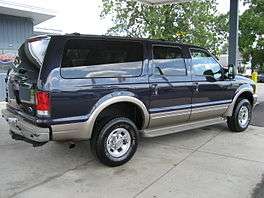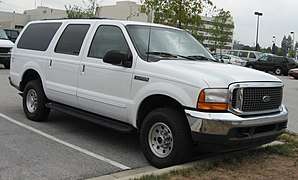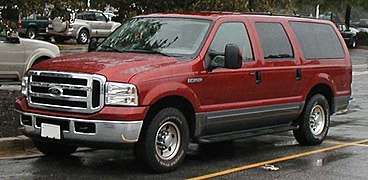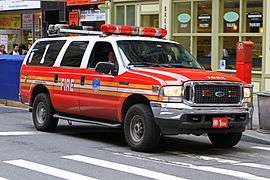Ford Excursion
The Ford Excursion is a heavy duty (Class 2), extended-length sport utility vehicle that was produced by Ford. The longest and heaviest SUV ever to enter mass production, the Excursion was marketed as a direct competitor of the 2500-series (¾-ton) Chevrolet Suburban/GMC Yukon XL[3][4] Introduced in September 1999[5] for the 2000 model year, a single generation was produced through the 2005 model year (a short 2006 production run was made for Mexico).
| Ford Excursion (UW137)[1] | |
|---|---|
 2000–2004 Ford Excursion | |
| Overview | |
| Manufacturer | Ford |
| Production | 1999 – September 30, 2005 |
| Model years | 2000–2006 (2006: Mexico only) |
| Assembly | Louisville, Kentucky, U.S. |
| Body and chassis | |
| Class | Full-size SUV |
| Body style | 4-door SUV with lift gate and 2 dutch doors[2] |
| Layout | Front engine, rear-wheel drive / four-wheel drive |
| Related | Ford Super Duty |
| Powertrain | |
| Engine | 5.4 L Triton V8 6.8 L Triton V10 7.3 L Powerstroke V8 turbodiesel 6.0 L PowerStroke V8 turbodiesel |
| Transmission | 4-speed automatic 5-speed automatic |
| Dimensions | |
| Wheelbase | 137.1 in (3,482 mm) |
| Length | 226.7 in (5,758 mm) |
| Width | 2000–01: 80.0 in (2,032 mm) 2002–05: 79.9 in (2,029 mm) |
| Height | 4WD: 77.2 in (1,961 mm) 2WD: 74.8 in (1,900 mm) |
| Curb weight | 7,688 lb (3,487 kg) (Turbodiesel) 7,230 lb (3,280 kg) (Gasoline) |
| Chronology | |
| Predecessor | Centurion C350 Classic (unofficial) |
| Successor | Ford Expedition EL/MAX |
Derived from the F-250 Super Duty pickup truck, the Ford Excursion was marketed primarily in North America; a limited number were sold for export. Following the discontinuation of the Excursion, Ford introduced the extended-length Ford Expedition EL/MAX; while matching the Chevrolet Suburban in terms of size, the Expedition EL/MAX shifted its chassis commonality from the Super Duty to the F-150. As of current production, Ford has not produced another SUV derived from the Super Duty model line.
Throughout its production run the Ford Excursion was assembled at the Kentucky Truck Plant in Louisville alongside Ford's Super Duty pickup trucks; the final example was produced on September 30, 2005.
Origin
For the 1973 model year, General Motors introduced its first four-door Suburban (sold by both Chevrolet and GMC). Far larger than the Jeep Wagoneer, the addition of a fourth passenger door allowed the Suburban to compete directly against the International Harvester Travelall wagon for the first time. After the 1975 discontinuation of the Travelall, the Suburban became the largest full-size SUV produced as a four-door wagon (a distinction it would hold for the next 25 years).
For 1978, Ford introduced the second-generation Ford Bronco, shifting the model line from the compact to the full-size SUV segment. Competing directly against the Chevrolet K5 Blazer/GMC Jimmy and Dodge Ramcharger, the Bronco adopted the chassis and powertrain of the F-100 pickup truck, in line with its GM and Chrysler counterparts. While the crew-cab General Motors C/K pickup formed the basis of the four-door Suburban wagon/SUV, Ford produced the Bronco strictly as a three-door wagon with a lift-off hardtop (continuing the most popular design of its predecessor). During the 1980s and early 1990s, Ford would market four-door Broncos built as license-built conversions (mating a Bronco body with F-Series crew cabs).[6][7]
For 1991, Ford would produce its first four-door SUV, as the compact Bronco II was replaced by the five-door Ford Explorer; both model lines were derived from the Ranger compact pickup truck.
For 1997, the Ford Expedition was introduced as the successor to the Bronco. Coinciding with changing segment demands, the Expedition was offered solely as a five-door wagon. While changing its body configuration, the Expedition retained F-Series chassis commonality with its Bronco predecessor. Sized between the Chevrolet Tahoe and Suburban, the Expedition was fitted with three-row seating (offered by the Suburban).
For 1999, Ford expanded the F-Series model range, with the F-250 and F-350 becoming the Super Duty series. Intended for work usage and towing, Super Duty F-Series trucks received a heavier-duty chassis and suspension along with a distinct body design. To compete against the 2500-series Suburban, Ford began development of a heavy-duty SUV derived from the F-250 Super Duty pickup truck.
Design overview
Chassis
The Ford Excursion was produced sharing the platform architecture of the F-250 Super Duty pickup truck. Sharing quite a bit of its chassis components and dimensions with the F-250 Super Cab, 8' Bed. The Excursion shares a common width, wheelbase, and front/rear track width with its F-250 counterpart. Other shared assemblies include the front and most of the rear suspension (the leaf springs and front spring hanger bracket were specific to the Excursion), along with the steering gear. From where the front sway bar mounts to the frame, back, is specific to the Excursion. And from this point back the frame is a little taller and much wider than its F-250 cousin. The rear axle for all Excursions was a Sterling 10.5 axle. The four wheel drive models were equipped with a NV273 transfer case and Dana 50 front axle. Gear ratios of 3:73 and 4:30 were offered.
During the development of the chassis, Ford learned that its initial design caused smaller vehicles (such as a Ford Taurus) to become severely overridden in a head-on collision. In the test, the tire of the Excursion drove up to the windshield of the Taurus (reducing the chance of survival for its driver).[8] As a response, Ford modified the chassis to include an under-bumper "blocker beam"; the device was initially tested by the French transportation ministry in 1971.[8] For the rear of the chassis, Ford chose to include a trailer hitch as standard equipment in production to reduce underriding in rear-end collisions by smaller vehicles.
Powertrain
During its entire production, the Excursion was offered with both gasoline and diesel engines. The standard engine was a 5.4L Triton V8 with a 6.8L V10 offered as an option. At its launch, the optional diesel engine was the Navistar-produced 7.3L Powerstroke V8; a 6.0L V8 was introduced during 2003, retaining the Powerstroke name.
All four engines were paired with an automatic transmission. The 4-speed 4R100 automatic was fitted to the 5.4., 6.8, and 7.3L engines, with a 5-speed 5R110W automatic fitted to the 6.0L engine.
Though using the ¾-ton chassis of the F-250, the Excursion was rated with a GVWR of 8,900 lb (4,000 kg) when equipped with gasoline engines and 9,200 lb (4,200 kg) with equipped with diesel engines. As its GVWR was above 8,500 lb (3,900 kg), the Excursion was exempt from EPA fuel economy ratings; reviewers cited fuel economy in the range of 12-15mpg with the V10 gasoline engine.[4] While its GVWR exempted it from emissions standards applied to light-duty vehicles, Ford designed the powertrains of the Excursion to meet low-emissions vehicle (LEV) status.[9]
| Engine | Configuration | Fuel | Production | Horsepower output | Torque output | Transmission |
|---|---|---|---|---|---|---|
| Ford Triton V8 | 5.4 L (330 cu in) SOHC 2V V8 | Gasoline | 2000–2005 | 255 hp (190 kW; 259 PS) | 350 lb⋅ft (475 N⋅m) | 4-speed automatic
Ford 4R100 |
| Ford Triton V10 | 6.8 L (413 cu in) SOHC 2V V10 | 310 hp (231 kW; 314 PS) | 425 lb⋅ft (576 N⋅m) | |||
| Ford/Navistar PowerStroke V8 | 7.3 L (444 cu in) OHV V8 turbo | Diesel | 2000–2003.5 | 250 hp (186 kW; 253 PS) | 525 lb⋅ft (712 N⋅m) | |
| Ford/Navistar PowerStroke V8 | 6.0 L (365 cu in) OHV 4V V8 turbo | 2003.5-2005 | 325 hp (242 kW; 330 PS) | 560 lb⋅ft (759 N⋅m) | 5-speed automatic
Ford 5R110W TorqShift[10] |
Body design
While the Ford Expedition shared design influences from the popular Ford Explorer, the Excursion adopted a high degree of commonality from its F-250 Super Duty counterpart. With the exception of its eggcrate grille (styled similar to the Ford Expedition and the third-generation Explorer), the front bodywork and two front doors are shared entirely with the Super Duty pickups, the rear doors are very similar to the Super Duty Crew Cab doors, but have more of a curve on the back side edge, thus being specific to the Excursion. Styled similar to the Bronco (with flush-mounted glass), the Excursion is fitted with a third-row seat and rear cargo area behind the second-row door; dependent on configuration, the vehicle could accommodate to nine passengers. In place of a conventional liftgate, the cargo door was configured as a 3-way design, pairing an upper liftgate with two lower dutch doors (similar to the 1992-2005 Chevrolet Astro); the taillamps were sourced from the E-Series van.
During its production, the Excursion saw few major changes to its interior or exterior. For 2002, the instrument panel was updated, receiving a digital odometer. For 2005, the eggcrate grille was replaced by the three-bar grille used on Super Duty trucks.
Coinciding with its design commonality with the Ford Super Duty crew cab, the Excursion is one of the only mass-produced SUVs ever produced with four full-length passenger doors (along with the Expedition MAX and Lincoln Navigator L, the Chevrolet Suburban and its GMC and Cadillac counterparts, and the International Travelall).
.jpg) Ford Excursion Limited (Germany)
Ford Excursion Limited (Germany) 2001 Ford Excursion Limited, rear view
2001 Ford Excursion Limited, rear view Ford Excursion XLT
Ford Excursion XLT Ford Excursion Eddie Bauer
Ford Excursion Eddie Bauer 2005 Ford Excursion XLT
2005 Ford Excursion XLT Ford Excursion XL (FDNY Battalion Chief vehicle)
Ford Excursion XL (FDNY Battalion Chief vehicle)
Trim
The Excursion adopted the trim nomenclature adopted across Ford light trucks in North America. The base trim was XL (marketed nearly exclusively for fleet sales), XLT (standard trim in retail markets), and Limited (highest trim line). Following its use across many Ford light trucks, an Eddie Bauer trim package was introduced for the Excursion for 2003 (differing from the Limited primarily in appearance).
XLT: Included three rows of seating, leather-wrapped steering wheel with speed control, a security system, keyless entry, 16 in (41 cm) chrome steel rims or optional alloy rims, trailer towing, and an AM/FM radio with cassette and single-disc CD player with six premium speakers, and air conditioning.
Limited: Included same features as XLT, but adds a power driver's seat, rear audio controls, illuminated running boards, 16 in (41 cm) alloy rims, front-speed sensitive windshield wipers, five power points, ten cupholders, heated front seats, leather seats, and an optional rear entertainment system with DVD player.
Reception
Being launched on September 30, 1999, the 2000 Ford Excursion was described by Popular Science as the "biggest sport utility on the planet."[11][12] 2000 would be the most successful model year for the Excursion, with nearly 69,000 examples sold. After largely meeting sales projections at its launch[9], demand for the model line was affected by the energy crisis of the 2000s. While able to produce 70,000 examples yearly[9], sales from 2001 onward struggled to reach half of that capacity, becoming the lowest-selling SUV sold by Ford or Lincoln-Mercury.
The large size of the Excursion led to it being dubbed the Ford Valdez by The Sierra Club in 1999 (in reference to the Exxon Valdez supertanker).[13] In 2007, TIME Magazine selected it as one of the Fifty Worst Cars of All Time.[14]
Variants
F-250 Tropivan
From 1998 to 2012, a second-party SUV conversion of the Ford F-250 was sold in Brazil.[15] Similar in design and layout to the Excursion, the F-250 Tropivan differed primarily in its being a second-party conversion (similar to the Centurion Classic). In contrast to the Excursion, two different wheelbases of the model were produced.
As with all Super Duty trucks in Brazil, the Tropivan had a different engine selection throughout its production run that included a 4.2 L Essex gasoline V6 and two diesels: a 3.9 L Cummins B-series and the 4.2 L straight-6 MWM Sprint 6.07TCA.
Aftermarket
During and since its production, the Excursion has become a basis for several types of aftermarket vehicles. As a result of its body commonality with the Super Duty model range, the bodywork of the Excursion led to aftermarket conversions of Ford medium-duty truck chassis (Ford F-650 and F-750) to SUVs; to accommodate the longer wheelbase, the body typically is fitted with an extra set of doors. At the other end of the size scale, the Hennessey VelociRaptor SUV was created by mating the rear bodywork of the Excursion with the bodywork of the first-generation Ford Raptor (a practice similar to the creation of the 1990s Centurion Classic C350). Other conversions involve fitting 2000-2005 Excursions with the front fascias of 2006-2016 Super Duty pickup trucks (as the Excursion shares its chassis with the F-250).
The Excursion also served as a basis for stretch limousines; coinciding with its heavier-duty chassis, many examples were stretched (unofficially) longer than the 120-inch limit imposed by Ford on the Lincoln Town Car sedan.
.jpg) Ford Excursion stretch limousine
Ford Excursion stretch limousine Ford Excursion armored car in use by the Taiwanese military police
Ford Excursion armored car in use by the Taiwanese military police 6-door Ford F-650 Super Duty SUV in Australia (Ford Excursion bodywork)
6-door Ford F-650 Super Duty SUV in Australia (Ford Excursion bodywork)
Yearly U.S. sales
| Calendar Year | Total American sales |
|---|---|
| 1999[16] | 18,315 |
| 2000 | 50,786 |
| 2001[17] | 34,710 |
| 2002[18] | 29,042 |
| 2003 | 26,259 |
| 2004[19] | 20,010 |
| 2005 | 16,283 |
References
- http://www.zaytran.com/Automotive_Projects.htm
- Consumer Guide Editors (2001). Consumer Guide Automobile Book, 2001. Publications International. p. 100. Retrieved 2015-07-27.
- McCosh, Dan, ed. (November 1999). "Big, bigger, biggest". Popular Science. 255 (5): 48. Retrieved 2015-12-31.
- Weitzman, Larry (2000). "The Ford Excursion, It doesn't get any Bigger". Theautochannel.com. Retrieved 2012-09-17.
- https://www.klik.com.my/item/story/479106/ford-excursion-makes-a-grand-debut
- Snitkoff, Edward. "Curbside Classic: Ford Classic 350 – Centurion Vehicles Creates A Frankenstein Suburban Fighter". Retrieved 2019-07-07.
- "This is the 4-Door Ford Bronco You Didn't Know Existed". web.archive.org. 2016-02-28. Retrieved 2019-07-07.
- Bradsher, Keith (2004). High and mighty: the dangerous rise of the SUV. PublicAffairs. p. 199. ISBN 978-1-58648-203-9. Retrieved 2012-06-12.
- "Ford Excursion makes a grand debut | KLiK". www.klik.com.my. Retrieved 2020-03-07.
- 2000, 2001, 2002, 2003, 2004, 2005 Ford Truck/SUV source books
- https://www.klik.com.my/item/story/479106/ford-excursion-makes-a-grand-debut
- "Big, bigger, biggest". Popular Science. 255 (5): 48. November 1999. Retrieved 2012-09-07.
- "ET 3/99: Ford's new gas-guzzling SUV wins the "Exxon Valdez" award from the Sierra Club". www.sdearthtimes.com. Retrieved 2020-03-07.
- "The 50 Worst Cars of All Time - TIME". Time. 2007-09-07. ISSN 0040-781X. Retrieved 2020-03-07.
- "Avaliação NA – F-250 Tropivan". Notícias Automotivas (in Portuguese). 13 December 2010. Retrieved 11 November 2017.
- "Ford Motor Company Sets New Full Year U.S. Sales Record". Theautochannel.com. Retrieved 2009-04-28.
- "Ford Motor Company's December U.S. Sales Climb 8.2 Percent" (PDF). Ford Motor Company. Archived from the original (PDF) on 2011-04-30. Retrieved 2012-06-16.
- "Ford's F-Series Truck Caps 22nd Year in a Row as America's Best-Selling Vehicle With a December Sales Record". Theautochannel.com. 2004-11-17. Retrieved 2009-04-28.
- "Ford Achieves First Car Sales Increase Since 1999". Theautochannel.com. 2004-11-17. Retrieved 2009-04-28.